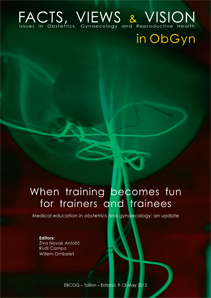The specialty of obstetrics and gynaecology offers a unique history of education. Gynaecology is a more recent field but obstetrics is as old as mankind. However, in ancient times, obstetrical knowledge was not accumulated or systematically taught.
In the 17 th century, the obstetrical forceps were invented by the Chamberlen family which was active in France and England. But the Chamberlen obstetricians deliberately kept their knowledge to themselves for 150 years to maintain their competitive edge. Their invention was not published and their knowledge was not shared for the benefit of a wider population. Fortunately, the attitude towards training has changed completely since the Chamberlen days.
Since then it has been universally accepted that the transfer of knowledge and abilities is a very important element of medicine and education is seen as a key element in the health sector in the same way as patient treatment and research.
Postgraduate medical training used to be very practical and take place in a Master-Apprentice relationship but gradually more and more theoretical knowledge has been incorporated into training and lately education and training are being developed at an unprecedented speed.
EBCOG – the European Board and College of Obstetrics and Gynaecology – has always had education and training as a key element of its activities. EBCOG has developed logbooks for training in general obstetrics and gynaecology and also, in cooperation with the four European subspecialty societies, for the subspecialties of perinatal medicine, gynaecological oncology, reproductive medicine and urogynaecology. Also EBCOG has developed and maintained a visitation and accreditation process for training centres throughout Europe and EBCOG is very active in organising Training the Trainers courses.
Therefore EBCOG is particularly pleased to present this monograph of papers by prominent colleagues from Europe and other parts of the world describing a number of current issues and developments in training within our field.
It is clear to us that training should be put into a wider perspective. Rather than simply being the transfer of knowledge, training should enable the professionals and the health care systems to prepare to cope with the requirements of a changing society. One very evident global change is the increasing focus on patient safety, a focus that must be apparent throughout our training programmes. The individual national authorities regulate the national training programmes but the European Union regulations are of increasing importance to us all, one example being the Directive regarding the mutual recognition of professional qualifications.
Previously the practical part of our training took place at the bedside, in the delivery room or in the operating theatre. This, however, is an unsafe and expensive learning environment and a score of methods for simula- tion-based learning have been developed throughout obstetrics and gynaecology. Simulation-based training methods also have the advantage of facilitating evaluation and, in some fields, even accreditation and certifi- cation.
We hope that in this monograph you will find inspiration for your further work with training in obstetrics and gynaecology and we wish to thank the contributors and the editors Professor Ziva Novak Antolic and Professor Willem Ombelet for their great work.



